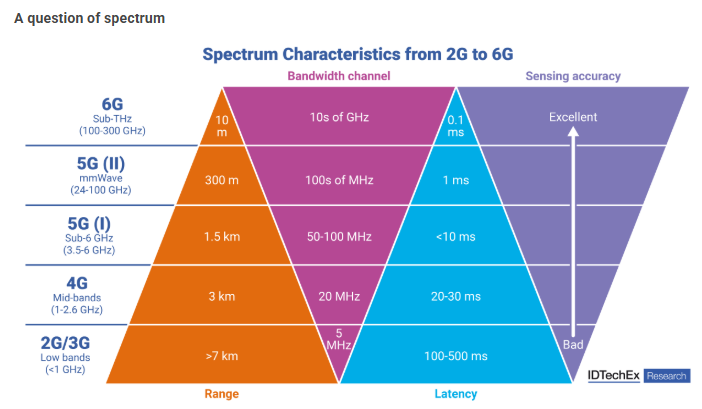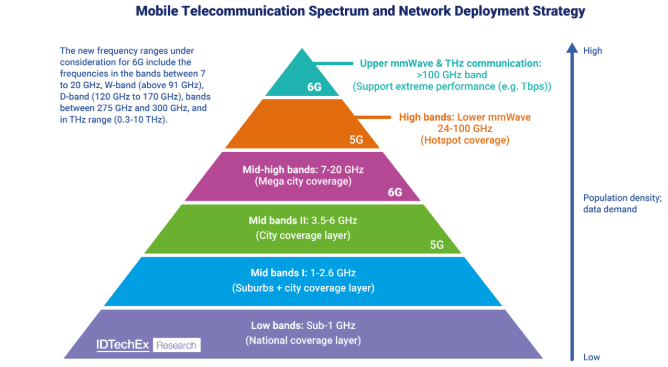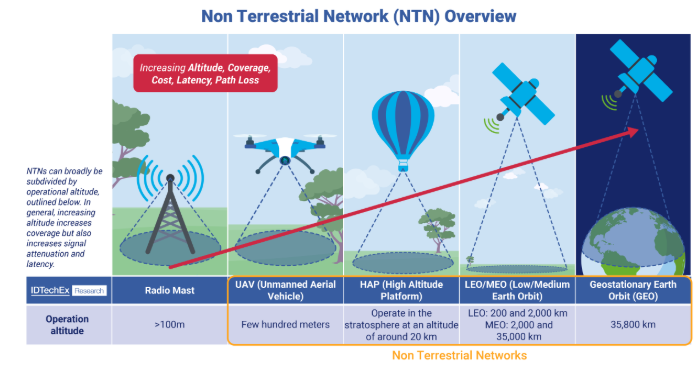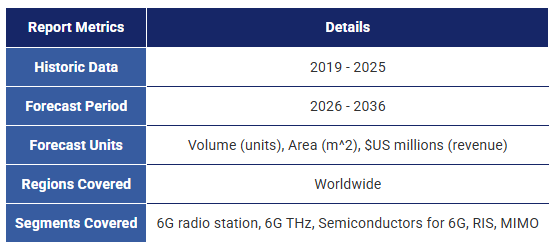6G市場2026-2036年:技術、動向、予測、プレーヤー6G Market 2026-2036: Technology, Trends, Forecasts, Players 6G、サブTHz、NTN、リコンフィギュラブル・インテリジェント・サーフェス(RIS)、分散MIMO、6G用半導体、アンテナ・パッケージング、低損失材料、ヘテロジニアス・インテグレーション。 通... もっと見る

サマリー
6G、サブTHz、NTN、リコンフィギュラブル・インテリジェント・サーフェス(RIS)、分散MIMO、6G用半導体、アンテナ・パッケージング、低損失材料、ヘテロジニアス・インテグレーション。
通信業界は10年ごとに、無線通信の新しい「世代」に突入する。2025年現在、業界は5Gの展開のほぼ半分を終えているが、その裏では、IDTechExが2030年頃に商用化されると予想する6Gの準備作業が順調に進んでいる。6Gとは何か、なぜ必要なのか、そしてその新機能を十分に活用するためにはどのような技術が必要なのか。

低帯域からサブTHz帯までの周波数特性の概要。一般的に、通信距離とデータ転送速度はトレードオフの関係にある。また、6GはSub-THz帯のみを使用するわけではなく、実際にはカバー範囲の大部分は中高周波数帯(7~15GHzのcmWaveなど)で提供され、より高い周波数は高密度ゾーン(スタジアムなど)で展開される見込みである。出典:IDTechEx:IDTechEx.
ワイヤレス通信は電磁信号に頼ってデータを伝送するが、多くの信号特性は信号の周波数(しばしばスペクトラムと呼ばれる)によって決まる。最も単純なレベルでは、低い周波数はより遠くまで伝搬し、高い周波数はより高いデータレートを可能にする。5Gでは、6GHz以下の周波数帯(3.5~6GHz)と、より高い周波数のmmWave(24~100GHz)が検討された。mmWaveは、はるかに高いデータ・レートと低遅延をもたらすとされたが、実装が困難なため、2025年現在、展開は低水準にとどまっており、一部の事業者は利用率の低い周波数帯の返還を余儀なくされている。
6Gに関しては、周波数帯に関する話題は、7~15GHzのいわゆる「cmWave」に集約されつつある。この周波数帯は、アップリンク/ダウンリンクの性能に優れ、信号の減衰特性も管理しやすいため、主力周波数帯になると予想されている。サブTHzのような高い周波数は、極端な性能のケースを想定して検討されているが、信号減衰に対抗するための未開発の技術(例えば、再構成可能なインテリジェント表面)に依存している。
6Gスペクトラム展開戦略の概要を下図に示す。定義上、THz帯は300GHzから10THzまでだが、電気通信の専門家は、100GHzを超えるアプリケーションをTHz通信として分類する方が単純であることに気づいている。

mmWaveとSub-THzが新たなアプリケーションと高速データ転送を可能にする一方で、ミッドバンドを活用して広範なカバレッジを実現する6G/5Gのスペクトラム展開戦略。出典IDTechEx.
5Gの展開から何を学ぶべきか?
5G展開のおよそ半分が終わった今、業界では失望感が広がっている。過剰に約束された性能は実現せず、5Gが可能にするはずの「ゲームを変える」アプリケーションは実現しなかった。5Gへの興奮がピークに達する中、モバイルネットワーク事業者(MNO)は周波数帯の取得やインフラの整備に莫大な費用を費やしたが、資本支出を正当化できるような新たな収益源の改善は見られなかった。IDTechExの6G市場・技術レポートの最新版では、6Gの展開に向けた教訓として、いくつかの主要な失敗が挙げられている
新世代には新技術が必要
高周波化は多くの技術的課題をもたらし、産業界と学界はこれらの問題を軽減するための技術ポートフォリオの開発に懸命に取り組んでいます。IDTechExのレポートでは、以下の分野における最新の開発状況を詳細に分析しています。
従来のタワーを超える
この報告書では、従来の基地局よりも広いカバレッジを提供する幅広い運用方法を網羅する非地上波ネットワーク(NTN)の成長市場についても調査している。ダイレクト2セル(D2C)の出現は、打ち上げコストの急落の直接的な結果であり、2025年にTモバイルとスターリンクはD2Cサービスを提供するために提携した。D2Cは現在、携帯電話の電波が届かない地域でごく基本的な緊急メールサービスを提供しているが、本レポートでは6GのD2Cがどのように無接続の人々をつなぐことができるのか、また衛星から直接デバイスにブロードバンドレベルの通信を提供する技術的限界はどの程度あるのかを探っている。

NTNには様々な技術があり、それぞれに利点、課題、応用がある。本レポートでは、これらの技術の6G D2Cへの適用可能性について検討する。出典IDTechEx.
2025年現在、業界は6Gの標準化の第一歩を踏み出し始めている。業界の10年サイクルに合わせると、6Gは2030年頃に商用化され始めることになる。6Gは技術的な性能パラメーターに著しい飛躍をもたらすだろうが、5Gと同様、新世代の高額な展開を正当化できるような収益化可能な新サービスを見出すことが中心的な課題となっている。IDTechExはまた、レポート内で従来の無線通信以外の潜在的なアプリケーションについても調査している。
6Gの技術、アプリケーション、市場に関する詳細は、IDTechExが新たに発表した6G市場調査レポートを参照されたい。「6G市場2026-2036:技術、動向、予測、プレーヤー」です。本レポートは、通信業界をカバーする長年の専門知識に基づき、最新の6G技術と市場開発動向、主要アプリケーション、プレイヤーの活動、業界展望に焦点を当て、読者に6G技術と市場の包括的な理解を提供することを目的としています。
主要な側面
本レポートでは、
6G技術動向
テラヘルツ通信用半導体技術
6G用フェーズアレイモジュール設計
6Gのパッケージングトレンド
Cell-free massive MIMO - 技術ベンチマークと包括的な概観を含むメタマテリアル
非地上ネットワーク(NTN)
モバイル通信以外の6Gユースケース
市場予測
目次1.要旨
1.1.モバイルトラフィックの伸びは鈍化
1.2.トラフィックの将来に関する競合するシナリオ
1.3.6G展開のスケジュール
1.4.6G業界の最新情報 - ベンダー
1.5.世界の6G政府支援イニシアティブ - 概要
1.6.6G向けオープンRAN
1.7.高データレート6G無線の技術目標
1.8.ミリ波フェーズドアレイ・システムにおける課題と解決策
1.9.さまざまな半導体技術のトランジスタ性能指標の概要
1.10.THz RF における半導体技術選択の概要
1.11.6G のアンテナモジュール設計動向
1.12.3つのアンテナパッケージング技術のベンチマーク
1.13.mmWave 5G および 6G における低損失材料の新たな可能性
1.14.6G アプリケーションの代表的な Dk と Df 値
1.15.ベンチマーク - 120 以上の低損失有機、無機、複合材料の Dk 対 Df
1.16.無線通信におけるMIMOの進化
1.17.なぜセルフリーMIMOなのか
1.18.6G - 主要アプリケーションの概要
1.19.NTNは5/6Gサービスを提供できるか?
1.20.機能の比較:HAPS vs LEO vs GEO
1.21.RIS-概要
1.22.RISの準備レベルに照らした商機
1.23.RIS - 予測サマリー(1)
1.24.RISの収益予測
1.25.6G 基地局(>100 GHz)の予測
2.無線通信入門
2.1.進化するモバイル通信の焦点
2.2.5Gの普及は急ピッチで進む
2.3.なぜ6Gを開発するのか?
2.4.ネットワーク事業者の負担
2.5.モバイル・データ・トラフィックの増加
2.6.モバイル・トラフィックの伸びは鈍化
2.7.トラフィックの将来に関する競合するシナリオ
2.8.中国におけるトラフィックの伸びの停滞
2.9.ワイヤレスはもうひとつのユーティリティになるか?
2.10.動画ストリーミングがトラフィックの主要アプリケーションに
2.11.さらなるストリーミング成長の余地はあるか?
2.12.ワイヤレス・ネットワークの高速化
2.13.アプリケーションと必要帯域幅
2.14.AIはトラフィックを増加させるか?
2.15.AIワークロード、オンデバイス対クラウド
2.16.自律性と将来のモビリティ
2.17.プラトゥーニング
2.18.5G展開からの教訓
3.6G入門
3.1.6Gとは何か?
3.2.IMT-2030強化性能要件
3.3.6G 展開のスケジュール
3.4.6G スペクトラム - どの帯域が考慮されるか?
3.5.バンドと帯域幅
3.6.6G スペクトラムと展開戦略
3.7.5G に対する 6G のパフォーマンス
3.8.100GHzを超える周波数
3.9.6G - 主要アプリケーションの概要
3.10.6G - 主な実現技術の概要(1)
3.11.6G - 主な実現技術の概要(2)
3.12.まとめ:6Gの世界的動向と新たな機会
3.13.ドコモ、NTTが富士通、NEC、ノキアと6G協定を締結
3.14.富士通、NTT、ドコモと6Gトライアルで提携
4.主要地域とプレーヤーによる 6G 開発ロードマップ
4.1.1.6G業界の最新情報 - ベンダー
4.1.2.3GPP - グローバル・スタンダード
4.1.3.3GPP ワーキンググループの要点
4.1.4.6G 向けスペクトラム
4.1.5.5G-Advと6Gのための上位6GHz帯
4.1.6.スタンドアロンと非スタンダロン展開
4.1.7.6G のオープン RAN
4.1.8.欧州における周波数競争
4.1.9.世界の6G政府支援イニシアティブ - 概要
4.1.10.6G 開発ロードマップ - 韓国
4.1.11.韓国 - mmWaveの課題
4.1.12.6G開発ロードマップ - 日本
4.1.13.次期移動通信インフラ研究のための資金調達モデル
4.2.米国
4.2.1.6G開発ロードマップ - 米国
4.2.2.米国のネットワーク事業者の概要
4.2.3.米国ネットワーク事業者の設備投資額
4.2.4.FCC、6GHz帯の周波数割り当てに関する方針を転換
4.2.5.ノキアの6G活動
4.2.6.エリクソンの6G活動(1)
4.2.7.エリクソンの6G活動(2)
4.2.8.エリクソン初期の6G事例
4.2.9.ファーウェイの6G活動
4.2.10.サムスンの6G活動
4.2.11.サムスンの6G戦略
5.6G 無線システムの分析
5.1.高データレート無線の技術目標
5.2.6Gトランシーバー・アーキテクチャの可能性
5.3.6G 無線システムの主要技術要素の概要
5.4.帯域幅と変調
5.5.100 Gbps~1 Tbps無線をサポートするための帯域幅要件
5.6.帯域幅とMIMO - 課題と解決策
5.7.6G無線の性能に影響する主なパラメータ
5.8.概念実証 - 100Gbps超の達成
5.9.無線リンク範囲とシステム利得
5.10.ハードウェア・ギャップ
5.11.THz帯における最大のボトルネック
5.12.飽和出力電力対周波数(全半導体技術) - 1
5.13.飽和出力電力対周波数(全半導体技術) - 2
5.14.レシーバノイズ - ハードウェアの課題
5.15.6G における低雑音増幅器(LNA)のための半導体の選択
5.16.位相雑音 - ハードウェアの課題
5.17.デジタル信号処理
5.18.主なTHz技術の概要表
5.19.総括表 - THzの主要特性
6.6G 無線機の消費電力解析
6.1.サブTHz無線機の構成要素
6.2.消費電力計算
6.3.PAの消費電力は周波数によって変化する
6.4.周波数が高くなると、伝送距離に大きな課題が生じる
6.5.トランシーバ側の消費電力(1)
6.6.トランシーバ側の消費電力(2)
6.7.トランシーバ側の消費電力(3)
6.8.受信機側の消費電力
6.9.まとめ(1)
6.10.まとめ(2)
7.6G用半導体
7.1.1.はじめに
7.1.2.6G アプリケーション用の半導体技術を選択する際に考慮すべきこと
7.1.3.最先端RFトランジスタの性能
7.2.Siベースの半導体:CMOS、SOI、SiGe
7.2.1.CMOS - 性能の限界
7.2.2.CMOS技術 - バルク対SOI
7.2.3.研究と産業における最先端のRF CMOS技術
7.2.4.FDSOI エコシステム - キープレイヤー
7.2.5.まとめ - RF CMOS SOI テクノロジー
7.2.6.SiGe
7.2.7.研究と産業における最先端の RF SiGe 技術
7.2.8.SiGe開発における欧州の取り組み
7.2.9.次世代SiGe BiCMOSへのインフィニオンとSTマイクロエレクトロニクスのアプローチ
7.2.10.まとめ - RF SiGe技術
7.3.GaAs と GaN
7.3.1.ワイドバンドギャップ半導体の基礎
7.3.2.6G における GaN の機会
7.3.3.RF用GaN-on-Si、SiCまたはダイヤモンド
7.3.4.100GHz用GaN-on-Siパワーアンプ?
7.3.5.GaNパワーアンプの現状
7.3.6.RF用GaNサプライヤーのまとめ
7.3.7.RF GaN製造ライン
7.3.8.6GにおけるGaAsのチャンス
7.3.9.最先端のGaAsベースアンプ
7.3.10.GaAsサプライヤーのまとめ
7.3.11.RFパワーアンプにおけるGaAsとGaNの比較
7.3.12.パワーアンプ技術のベンチマーク
7.4.InP
7.4.1.最先端のInP技術
7.4.2.InP HEMT と InP HBT の比較
7.4.3.6G における InP の可能性
7.4.4.InP と SiGe BiCMOS の異種集積
7.4.5.最先端のInPパワーアンプ-性能とプレーヤー
7.5.テラヘルツ通信用半導体のまとめ
7.5.1.6G用Si半導体とIII-V半導体の比較
7.5.2.テラヘルツ通信用半導体に関する課題
7.5.3.さまざまな半導体技術のトランジスタ性能指標の概要
7.5.4.200 GHz を超える周波数帯におけるパワーアンプのベンチマーク
7.5.5.200GHz を超える周波数帯におけるパワーアンプのベンチマーク(2)
7.5.6.D バンド(110GHz~170GHz)におけるパワーアンプ技術のベンチマーク
7.5.7.THz RF における半導体技術選択の概要
7.5.8.まとめ
8.6G 用フェーズアレイアンテナ
8.1.1.6G 用アンテナ
8.1.2.mmWave フェーズドアレイシステムにおける課題と解決策
8.1.3.周波数が高くなるにつれて小さくなるアンテナサイズ
8.1.4.アンテナのアプローチ
8.1.5.6Gアンテナの課題
8.1.6.アンテナ利得対アレイ数
8.1.7.パワーとアンテナアレイサイズのトレードオフ
8.1.8.5G フェーズアレーアンテナ
8.1.9.アンテナメーカー
8.1.10.6G 90GHz フェーズアレーアンテナ - ノキアによるデモ
8.1.11.28, 90, 140 GHzにおけるフェーズアレイの技術ベンチマーク。
8.1.12.140GHz フェーズアレイ - トランシーバーの解析
8.1.13.140GHz アレイ用半導体の選択
8.1.14.140GHz フェーズ・アレイを構築する際の考慮事項
8.2.最先端の D バンド(110~175GHz)位相アレイ・モジュールの例
8.2.1.サムスンの最新 THz プロトタイピング・ワイヤレス・プラットフォーム(適応送受信ビームフォーミング付き)
8.2.2.サムスンの 140GHz THz プロトタイプ - デバイス・アーキテクチャ
8.2.3.サムスンと UCSB による 140 GHz THz プロトタイプ - IC とアンテナ製造の詳細
8.2.4.UCSB 135 GHz MIMO ハブ・トランスミッター・アレイ・タイル・モジュール
8.2.5.LTCC キャリアへの InP PA の実装
8.2.6.ノキアの D バンド(110~170GHz)フェーズドアレイ・オン・ガラス・モジュール用完全集積 2D スケーラブル TX/RX チップセット
8.2.7.130GHz ワイヤレス 2x2 ラインオブサイト(LoS)MIMO の概念実証 - 1
8.2.8.概念実証用 130GHz ワイヤレス 2x2 ライン・オブ・サイト(LoS)MIMO - 2
8.2.9.UCSD による 136-147GHz ウェーハスケールフェーズドアレイ送信機のデモ - 1
8.2.10.UCSD による 136-147 GHz ウェーハスケール・フェーズドアレイ送信機のデモ - 2
8.2.11.最先端の D バンド・トランスミッターのベンチマーク
9.6G のパッケージング傾向
9.1.6G のアンテナモジュール設計動向
9.2.パッケージング要件
9.3.アンテナパッケージング技術オプションの選択
9.4.mmWaveアンテナ統合の3つの方法
9.5.つのアンテナパッケージング技術のベンチマーク
9.6.次世代フェーズドアレイターゲット
9.7.アンテナパッケージングと動作周波数
9.8.集積技術のトレードオフ
9.9.CMOS上にInPを集積するアプローチ
9.10.ミリ波におけるアンテナ集積の課題
9.11.ワイヤレスシステムにおけるAiPとディスクリートアンテナ技術の比較
9.12.AiPの主な設計上の考慮点
9.13.AiP用基板材料のベンチマーク
9.14.AiP用基板技術のベンチマーク
9.15.6G用アンテナ・オンチップ(AoC)
9.16.5G および 6G RF FEM における複数の送信機の共存(Skyworks Solutions 社より)(1)
9.17.5Gおよび6G RF FEMのマルチトランスミッター共存(Skyworks Solutionsより)(2)
9.18.5Gから6Gへのハードウェアコンポーネントの進化
9.19.周波数>100 GHzにおけるパッケージングの課題
9.20.5Gと6GのAiP、2024年~2034年
10.ミリ波および THZ 向け低損失材料
10.1.mmWave 5G および 6G における低損失材料の新たな可能性
10.2.アプリケーション別に要求される典型的な Dk 値と Df 値
10.3.低損失材料の選択において考慮すべき重要な要素
10.4.5G/6G 用低損失材料の概要
10.5.ベンチマーク - 120以上の有機、無機、複合低損失材料のDk対Df
10.6.5G、6G、THz PCB/部品向け商用低損失材料の現状と展望
10.7.5G および 6G 低損失材料の詳細
11.6G 向け MIMO
11.1.無線通信におけるMIMOの進化
11.2.mMIMOの課題
11.3.分散 MIMO
11.4.セルフリーの大規模分散MIMO
11.5.6G Massive MIMOに関する考察
11.6.なぜセルフリーMIMOなのか
11.7.様々なMIMOアプローチのベンチマーク
11.8.セルフリーMIMOの利点と課題
11.9.セルフリーmMIMO用アンテナ処理ユニットの例
12.6G 非地上波ネットワーク(NTN)
12.1.エグゼクティブサマリー
12.2.世界的な接続性の格差
12.3.接続性ギャップにおける大きな地域格差
12.4.LEOのNTNの開発
12.5.打ち上げコストの低下がNTNを可能にする
12.6.異なるタイプのNTN技術のベンチマーク
12.7.特徴の比較:HAPS対LEO対GEO
12.8.セルへの直接アクセス
12.9.ビーム伝搬における距離の影響
12.10.自由空間経路損失
12.11.D2C用NTNの比較
12.12.NTNは5/6Gサービスを提供できるか?
12.13.D2Cのビジネスモデル
12.14.スターリンクとD2Cの経済性
12.15.地上波以外のネットワークを可能にする技術の概要
13.再構成可能なインテリジェント表面(RIS)とメタマテリアル
13.1.1.RIS - エグゼクティブ・サマリー(1)
13.1.2.RIS - エグゼクティブ・サマリー(2)
13.1.3.RIS - 概要
13.1.4.高周波通信の課題
13.1.5.スマート電磁デバイスの主な特性とパラメータの概要
13.1.6.異種スマート電磁(EM)環境
13.1.7.RISと他のスマートEM機器との技術ベンチマーク
13.1.8.RISとMassive MIMOの比較
13.1.9.RISと従来の反射アレーアンテナとの比較
13.1.10.RIS vs リレー
13.1.11.RIS vs Relay技術ベンチマーク
13.1.12.スマート EM デバイスの主な特性とパラメーターの概要
13.1.13.RISの動作周波数
13.1.14.RISの主な推進要因
13.1.15.RISの主な課題
13.1.16.完全に機能するRIS環境の課題
13.1.17.RISの主な使用例
13.2.RISハードウェア
13.2.1.メタマテリアル - 概要
13.2.2.電気通信における RIS 用メタマテリアル
13.2.3.競合する複数のメタマテリアル製造方法
13.2.4.メタマテリアルの詳細
13.2.5.RISアーキテクチャ
13.2.6.RIS信号伝播制御
13.2.7.パッシブ、ハイブリッド、アクティブRIS
13.2.8.パッシブ、ハイブリッド、アクティブRISのベンチマーク
13.2.9.アクティブRIS - そのユースケースは? - 1
13.2.10.アクティブRIS - そのユースケースは? - 2
13.2.11.RISの様々なモード - ベンチマーク
13.2.12.透過型RISの2つの設計アプローチ
13.2.13.透過型RISデバイス:1ビット設計と2ビット設計
13.2.14.透過型 RIS デバイス:連続位相シフト設計
13.2.15.同時送信・反射(STAR)再構成可能インテリジェント・サーフェス(RIS)
13.2.16.RIS はどのようにして効率的なパッシブ・ビームフォーミングを実現できるか
13.2.17.RIS のパワーパラドックス:高周波通信ネットワークにおける効率性の課題
13.2.18.RIS 展開の強化:コンピュータ・シミュレーションからの洞察
13.2.19.RIS のための材料と製造
13.2.20.液晶ポリマー(LCP)は、アクティブなメタサーフェスを作る有望な方法である
13.2.21.LCPと半導体RISの比較
13.2.22.RISの課題
13.2.23.無線ネットワークにおける典型的なRISアプリケーション
13.2.24.場所別のRISユースケース
13.2.25.再構成可能なインテリジェント表面(RIS)の現状
13.2.26.NANOWEBはパッシブRISの一例
13.2.27.Pivotal Commware、ハイブリッドRISのホログラフィック・ビームフォーミングを開発
13.2.28.Pivotal Commware、2023年に1億200万米ドルの資金を確保し、mmWave無線FWA展開を加速
13.2.29.グリーンウェーヴス
13.2.30.ZTE の 5G アドバンストおよび 6G 向け RIS ソリューション
13.2.31.ZTE は 6G 向けの 2 つの重要な RIS アプリケーションを特定
13.2.32.RIS における通信事業者の活動
13.2.33.RISE-6G、無線通信におけるメタマテリアルの利用を調査
13.2.34.ガラス窓の金属酸化物が干渉を引き起こす
13.2.35.高周波通信用の一体型透明アンテナの構築
13.2.36.低放射率コーティングに周波数選択性を持たせる
13.2.37.アルキャン・システムズ社、透明液晶フェーズドアレイアンテナを開発
13.3.RISと他のスマート電磁(EM)デバイスのベンチマーク
13.3.1.RISの準備レベルに対する商機
13.3.2.ファーウェイの 6G RIS プロトタイプ・デモ
13.3.3.ファーウェイの 6G RIS プロトタイプ・デモの結果
13.4.RIS の予測
13.4.1.RIS の収益予測
13.4.2.RIS エリア予測、2025 年~2036 年
14.モバイル通信以外の 6G ユースケース
14.1.無線ネットワークの高速化のケース
14.2.6G - 主要アプリケーションの概要
14.3.ワイヤレス認知
14.4.テラヘルツ波センシング - 概要
14.5.THzセンシングの動作原理
14.6.ガスセンシングとイメージング用のTHzセンサーに関するアップル社の特許
14.7.THzイメージング - 概要
14.8.THzセンシングとイメージング-テラセンスの例
14.9.THz精密位置決め - 概要
14.10.ファーウェイの統合センシング通信(ISAC)プロトタイプ(1)
14.11.ファーウェイの統合センシング通信(ISAC)プロトタイプ(2)
14.12.デジタル・ツインニング
14.13.周波数範囲 275-450 GHz における陸上移動サービス・アプリケーションの概要
14.14.275-450 GHz における潜在的なユースケース(1)
14.15.275-450 GHz における潜在的ユースケース(2)
15.市場予測
15.1.RIS - フォーキャスト・サマリー(1)
15.2.RIS -予測概要(2)
15.3.RIS の売上予測
15.4.RISエリア予測、2025~2036年
15.5.6G ベースステーション(>100 GHz)の予測
16.企業プロファイル
16.1.アルキャン・システムズ
16.2.アンプレオン
16.3.Atheraxon
16.4.コムスコープ
16.5.エリクソン(2020年)
16.6.エリクソン(2021年)
16.7.エリクソン(2025年)
16.8.フレッシュウェーブ
16.9.GaN Systems
16.10.ファーウェイ
16.11.京セラ
16.12.メタマテリアル
16.13.ノキア
16.14.NXPセミコンダクターズ
16.15.オムニフロー
16.16.ピココム
16.17.ピボタル・コムウェア
16.18.ルネサスエレクトロニクス
16.19.ソルベイ
16.20.TMYTEK
16.21.ZTE
Summary
6G, sub-THz, NTNs, Reconfigurable Intelligent Surfaces (RIS), Distributed MIMO, Semiconductors for 6G, antenna packaging, low-loss materials, heterogeneous integration.
Every 10-years, the telecoms industry enters a new 'Generation' of wireless communications. As of 2025, the industry is roughly half-way through its rollout of 5G, but behind the scenes work is well underway on preparing 6G which IDTechEx expects to enter commercialization around 2030. What is 6G, why is it needed, and what technologies will be required to fully leverage its new capabilities?

An overview of the spectrum characteristics from low bands up to Sub-THz. In general there is a trade-off between range and data transfer rate. Also note that 6G will not exclusively use Sub-THz, in fact the bulk of the coverage will be provided by mid-high bands (e.g. cmWave from 7-15 GHz), while higher frequencies are expected to be deployed in high-density zones (such as stadiums). Source: IDTechEx.
Wireless communications rely on electromagnetic signals to transmit data, with many signal characteristics determined by the frequency of the signals (often referred to as spectrum). At the simplest level, lower frequencies can propagate further while higher frequencies can enable higher data rates. For 5G, the new bands under consideration were the sub-6 GHz (3.5 - 6 GHz) and the higher frequency mmWave (24-100 GHz). mmWave was purported to bring much higher data rates and lower latencies, but challenging implementation have meant deployments remain low as of 2025, with some operators even forced to hand back under-utilized spectrum.
For 6G, the conversation about spectrum is largely coalescing around the so called 'cmWave', 7-15 GHz. This is expected to be the workhorse spectrum band, offering both good uplink/downlink performance but also manageable signal attenuation properties. Higher frequencies, such as sub-THz, are being explored for extreme performance cases, but rely on a host of as yet undeveloped technologies to combat signal attenuation (for example, reconfigurable intelligent surfaces).
An overview of 6G spectrum deployment strategy is shown in the figure below. Note that even though by definition the THz band runs from 300 GHz to 10 THz, telecom professionals have found it simpler to classify beyond-100 GHz applications as THz communications.

Spectrum deployment strategy for 6G/5G, utilizing the mid bands to give broad coverage whilst mmWave and Sub-THz enable new applications and high data rates. Source: IDTechEx.
What lessons are to be learned from the 5G rollout?
Roughly halfway through the 5G rollout, there is a widespread sense of disappointment in the industry. Overpromised performance has failed to deliver, while 'game-changing' applications that 5G would enable never materialized. Amidst the peak excitement for 5G, mobile network operators (MNOs) spent extraordinary amounts on acquiring spectrum and building out infrastructure, but new and improved revenue streams have not been found to justify the capital expenditures. In IDTechEx's latest version of its 6G market and technology report, several key failures are identified, as well as lesson for the rollout of 6G
New generation requires new technologies
The move to higher frequencies brings a host of technical challenges, and industry and academia are working hard to develop a portfolio of technologies to mitigate these issues. IDTechEx's report takes a deep dive into the latest developments across
Going beyond traditional towers
The report also explores the growing market of non-terrestrial networks (NTNs), which encompasses a wide range of operational methods of providing greater coverage than a traditional base station. The emergence of direct-2-cell (D2C) has been a direct consequence of the steep decline in launch costs, and in 2025 T-Mobile and Starlink partnered to offer D2C services. D2C currently provides very basic emergency text services in areas without cellular coverage, and the report explores how D2C in 6G could connect the unconnected, and what technical limits exist to providing broadband level coverage from a satellite direct to device.

NTNs encompass a variety of different technologies, each with advantages, challenges, and applications. The applicability of these to 6G D2C is explored in the report. Source: IDTechEx.
First commercial 6G systems expected by 2030
As of 2025, the industry is beginning to enter the first steps of standardization for 6G, a process that is expected to be complete by the end of the decade. Fitting with the industries 10-year cycles, 6G will begin to be commercialized around 2030. 6G will bring a marked leap in technical performance parameters, but with 5G, the core challenge remains finding monetizable new services that can justify the expensive rollout of a new generation. IDTechEx also explores potential applications beyond traditional wireless communications within the report.
To learn more about 6G's technology, applications, market, please refer to IDTechEx's newly released 6G market research report. "6G Market 2026-2036: Technology, Trends, Forecasts, Players". This 6G report is built on years of expertise covering the telecoms industry, and focuses on the latest 6G technology and market development trends, key applications, player activities, and industry outlook, aiming to provide the reader a comprehensive understanding of 6G technology and market.
Key Aspects
This report includes a comprehensive review of the technology, players, use case studies, and market for 6G
6G Technology trends
Semiconductor technologies for THz communication
Phase array module design for 6G
Packaging trend for 6G
Cell-free massive MIMO - including technology benchmark and a comprehensive overviewMetamaterials
Non-terrestrial networks (NTN)
6G use cases beyond mobile communication
Market Forecasts
Table of Contents1. EXECUTIVE SUMMARY
1.1. Growth of Mobile Traffic Slows
1.2. Competing Narratives Regarding the Future of Traffic
1.3. 6G Rollout Timeline
1.4. 6G Industry Update - Vendors
1.5. Global 6G government-aided initiatives - an overview
1.6. Open RAN for 6G
1.7. Technical Targets for High Data-Rate 6G Radios
1.8. Navigating Challenges and Solutions in mmWave Phased Array Systems
1.9. Overview of transistor performance metrics of different semiconductor technologies
1.10. Overview of semiconductor technology choice for THz RF
1.11. Antenna Module Design Trends for 6G
1.12. Benchmarking Three Antenna Packaging Technologies
1.13. New opportunities for low-loss materials in mmWave 5G and 6G
1.14. Typical Dk and Df Values for 6G Applications
1.15. Benchmark - Dk vs Df of over 120 low-loss organic, inorganic & composite materials
1.16. Evolution of MIMO in Wireless Communications
1.17. Why Cell-Free MIMO
1.18. 6G - Key Applications Overview
1.19. Can NTNs Provide 5/6G Service?
1.20. Features comparison: HAPS vs LEO vs GEO
1.21. RIS - Overview
1.22. Commercial opportunities against readiness levels of RIS
1.23. RIS - Forecast Summary (1)
1.24. RIS Revenue Forecasts
1.25. 6G Base Stations (>100 GHz) Forecast
2. INTRODUCTION TO WIRELESS COMMUNICATIONS
2.1. Evolving mobile communication focus
2.2. 5G Rollout Continues at Pace
2.3. Why Develop 6G?
2.4. Burdens on Network Operators
2.5. Growth in Mobile Data Traffic
2.6. Growth of Mobile Traffic Slows
2.7. Competing Narratives Regarding the Future of Traffic
2.8. Traffic Growth Plateau in China
2.9. Will Wireless Become Another Utility?
2.10. Video Streaming Increasingly the Dominant Application of Traffic
2.11. Is There Room for More Streaming Growth?
2.12. The Case for Faster Wireless Networks
2.13. Applications and Required Bandwidths
2.14. Will AI Drive Traffic Up?
2.15. AI Workload, On-Device vs Cloud
2.16. Autonomy and Future Mobility
2.17. Platooning
2.18. Lessons From 5G Rollout
3. INTRODUCTION TO 6G
3.1. What is 6G?
3.2. IMT-2030 Enhanced Performance Requirements
3.3. 6G Rollout Timeline
3.4. 6G spectrum - which bands are considered?
3.5. Bands vs Bandwidth
3.6. 6G Spectrum and Deployment Strategy
3.7. 6G performance with respect to 5G
3.8. Frequencies Beyond 100GHz
3.9. 6G - an overview of key applications
3.10. 6G - Overview of key enabling technologies (1)
3.11. 6G - Overview of key enabling technologies (2)
3.12. Summary: Global trends and new opportunities in 6G
3.13. DoCoMo, NTT sign 6G pact with Fujitsu, NEC, Nokia
3.14. Fujitsu teams with NTT and Docomo for 6G trials
4. 6G DEVELOPMENT ROADMAP FROM KEY REGIONS & PLAYERS
4.1.1. 6G Industry Update - Vendors
4.1.2. 3GPP - Global Standards
4.1.3. 3GPP Working Group Takeaways
4.1.4. Spectrum for 6G
4.1.5. Upper 6 GHz band for 5G-Adv and 6G
4.1.6. Standalone vs Non-Standalone Rollout
4.1.7. Open RAN for 6G
4.1.8. Competition for Spectrum in Europe
4.1.9. Global 6G government-aided initiatives - an overview
4.1.10. 6G development roadmap - South Korea
4.1.11. South Korea - mmWave Challenges
4.1.12. 6G development roadmap - Japan
4.1.13. Funding models to research the next mobile communication infrastructure
4.2. USA
4.2.1. 6G development roadmap - US
4.2.2. US Network Operator Overview
4.2.3. CAPEX Spending of US Network Operators
4.2.4. FCC Shifts Policy Regarding 6GHz Spectrum Allocation
4.2.5. Nokia's 6G activity
4.2.6. Ericsson's 6G activity (1)
4.2.7. Ericsson's 6G activity (2)
4.2.8. Ericsson Early 6G Examples
4.2.9. Huawei's 6G activity
4.2.10. Samsung's 6G activity
4.2.11. Samsung's strategy to 6G
5. 6G RADIO SYSTEM ANALYSIS
5.1. Technical Targets for High Data-Rate Radios
5.2. Potential 6G transceiver architecture
5.3. Overview of key technical elements in 6G radio system
5.4. Bandwidth and Modulation
5.5. Bandwidth requirements for supporting 100 Gbps - 1 Tbps radios
5.6. Bandwidth and MIMO - Challenges and Solutions
5.7. Key parameters that affect the 6G radio's performance
5.8. Proof of concepts - achieving beyond 100 Gbps
5.9. Radio link range vs system gain
5.10. Hardware Gap
5.11. The biggest bottleneck in THz region
5.12. Saturated output power vs frequency (all semiconductor technologies) - 1
5.13. Saturated output power vs frequency (all semiconductor technologies) - 2
5.14. Receiver Noise - Hardware Challenges
5.15. Choices of semiconductor for low noise amplifiers (LNA) in 6G
5.16. Phase noise - hardware challenges
5.17. Digital signal processing
5.18. Summary table of key THz Technologies
5.19. Summary table - key THz Characteristics
6. POWER CONSUMPTION ANALYSIS OF A 6G RADIO
6.1. Building blocks for sub-THz radio
6.2. Power consumption calculation
6.3. Power consumption of PA scale with frequency
6.4. Higher frequency poses significant challenges in transmission distance
6.5. Power Consumption on the Transceiver Side (1)
6.6. Power Consumption on the Transceiver Side (2)
6.7. Power Consumption on the Transceiver Side (3)
6.8. Power Consumption on the Receiver Side
6.9. Summary (1)
6.10. Summary (2)
7. SEMICONDUCTORS FOR 6G
7.1.1. Introduction
7.1.2. What to consider when choosing semiconductor technologies for 6G applications
7.1.3. State of the art RF transistors performance
7.2. Si-based semiconductor: CMOS, SOI, SiGe
7.2.1. CMOS - Performance Limitations
7.2.2. CMOS technology - Bulk vs SOI
7.2.3. State-of-the-art RF CMOS technology in research and industry
7.2.4. FDSOI Ecosystem - key players
7.2.5. Summary - RF CMOS SOI Technology
7.2.6. SiGe
7.2.7. State-of-the-art RF SiGe technology in research and industry
7.2.8. Europe's Efforts in SiGe Development
7.2.9. Infineon and STMicroelectronics approaches to next generation SiGe BiCMOS
7.2.10. Summary - RF SiGe technology
7.3. GaAs and GaN
7.3.1. Wide Bandgap Semiconductor Basics
7.3.2. GaN's opportunity in 6G
7.3.3. GaN-on-Si, SiC or Diamond for RF
7.3.4. GaN-on-Si power amplifier for 100 GHz?
7.3.5. State of the art GaN power amplifier
7.3.6. Summary of RF GaN Suppliers
7.3.7. RF GaN Fabrication Lines
7.3.8. GaAs's opportunity for 6G
7.3.9. State-of-the-art GaAs based amplifier
7.3.10. Summary of GaAs suppliers
7.3.11. GaAs vs GaN for RF Power Amplifiers
7.3.12. Power amplifier technology benchmark
7.4. InP
7.4.1. State-of-the-art InP technology
7.4.2. InP HEMT vs InP HBT
7.4.3. InP opportunities for 6G
7.4.4. Heterogenous integration of InP with SiGe BiCMOS
7.4.5. State-of-the-art InP power amplifiers - the performance and the players
7.5. Summary of semiconductors for THz communication
7.5.1. Overview of Si vs III-V semiconductors for 6G
7.5.2. Challenges regarding semiconductor for THz communications
7.5.3. Overview of transistor performance metrics of different semiconductor technologies
7.5.4. Power amplifier benchmark in beyond 200 GHz frequency band
7.5.5. Power amplifier benchmark in beyond 200 GHz frequency band (2)
7.5.6. Power amplifier technology benchmark in D band (110 GHz - 170 GHz)
7.5.7. Overview of semiconductor technology choice for THz RF
7.5.8. Summary
8. PHASE ARRAY ANTENNAS FOR 6G
8.1.1. Antennas for 6G
8.1.2. Navigating Challenges and Solutions in mmWave Phased Array Systems
8.1.3. Antenna Size Shrinks With Increasing Frequency
8.1.4. Antenna approaches
8.1.5. Challenges in 6G antennas
8.1.6. Antenna gain vs number of arrays
8.1.7. Trade off between power and antenna array size
8.1.8. 5G phase array antenna
8.1.9. Antenna Manufacturers
8.1.10. 6G 90 GHz phase array antenna - demonstration from Nokia
8.1.11. Technology benchmark of phase array in 28, 90, and 140 GHz.
8.1.12. 140 GHz phase array - transceiver analysis
8.1.13. Choice of Semiconductor for 140GHz Array
8.1.14. Considerations when building a 140 GHz phase array
8.2. Examples of state-of-the-art D-band (110 - 175 GHz) phase array modules
8.2.1. Samsung's latest THz prototyping wireless Platform with Adaptive Transmit and Receive Beamforming
8.2.2. 140 GHz THz prototype from Samsung - device architecture
8.2.3. 140 GHz THz prototype from Samsung and UCSB - IC and antenna fabrication details
8.2.4. UCSB 135 GHz MIMO hub transmitter array tile module
8.2.5. Mounting InP PA to the LTCC Carrier
8.2.6. Fully Integrated 2D Scalable TX/RX Chipset for D-Band (110 to 170GHz) Phased-Array-on-Glass Modules from Nokia
8.2.7. A proof-of-concept 130 GHz wireless 2x2 line-of-sight (LoS) MIMO - 1
8.2.8. A proof-of-concept 130 GHz wireless 2x2 line-of-sight (LoS) MIMO - 2
8.2.9. A 136-147 GHz Wafer-Scale Phased-Array Transmitter demo from UCSD - 1
8.2.10. A 136-147 GHz Wafer-Scale Phased-Array Transmitter demo from UCSD - 2
8.2.11. State-of-the-art D-band transmitters benchmark
9. PACKAGING TREND FOR 6G
9.1. Antenna Module Design Trends for 6G
9.2. Packaging Requirements
9.3. Choice of Antenna Packaging Technology Options
9.4. Three ways of mmWave antenna integration
9.5. Benchmarking Three Antenna Packaging Technologies
9.6. Next Generation Phased Array Targets
9.7. Antenna Packaging vs Operational Frequency
9.8. Trade-Off in Integration Technologies
9.9. Approaches to Integrate InP on CMOS
9.10. Antenna Integration Challenges in mmWave
9.11. AiP vs Discrete Antenna Techniques in Wireless Systems
9.12. Key Design Considerations for AiP
9.13. Benchmark of Substrate Materials for AiP
9.14. Benchmark of Substrate Technologies for AiP
9.15. Antenna on Chip (AoC) for 6G
9.16. Multiple transmitter coexistence for 5G and 6G RF FEM (from Skyworks Solutions) (1)
9.17. Multiple transmitter coexistence for 5G and 6G RF FEM (from Skyworks Solutions) (2)
9.18. Evolution of Hardware Components from 5G to 6G
9.19. Packaging Challenges for Freq. >100 GHz
9.20. mmWave AiP ecosystem
9.21. AiP for 5G and 6G, 2024-2034
10. LOW-LOSS MATERIALS FOR MMWAVE AND THZ
10.1. New opportunities for low-loss materials in mmWave 5G and 6G
10.2. Typical Dk and Df values requirements by applications
10.3. Important factors to consider for the selection of low-loss materials
10.4. Overview of low-loss materials for 5G/6G
10.5. Benchmark - Dk vs Df of over 120 low-loss organic, inorganic & composite materials
10.6. Status and outlook of commercial low-loss materials for 5G, 6G, and THz PCBs/ components
10.7. More info about 5G and 6G Low Loss Materials
11. MIMO FOR 6G
11.1. Evolution of MIMO in Wireless Communications
11.2. Challenges with mMIMO
11.3. Distributed MIMO
11.4. Cell-free Massive MIMO (Large-Scale Distributed MIMO)
11.5. Considerations for 6G Massive MIMO
11.6. Why Cell-Free MIMO
11.7. Benchmarking of Different MIMO Approaches
11.8. Benefits and Challenges of Cell-Free MIMO
11.9. An Example of Antenna Processing Unit for Cell-Free mMIMO
12. 6G NON-TERRESTRIAL NETWORKS (NTN)
12.1. Executive Summary
12.2. The Global Connectivity Gap
12.3. Large Regional Disparity in Connectivity Gaps
12.4. Development of LEO NTNs
12.5. Falling Launch Costs Enable NTNs
12.6. Benchmark of different types of NTN technologies
12.7. Features comparison: HAPS vs LEO vs GEO
12.8. Direct to Cell
12.9. Impact of Distance on Beam Propagation
12.10. Free Space Path Loss
12.11. Comparison of NTNs for D2C
12.12. Can NTNs Provide 5/6G Service?
12.13. D2C Business Models
12.14. Economics of Starlink and D2C
12.15. Overview of enabling technologies for non-terrestrial networks
13. RECONFIGURABLE INTELLIGENT SURFACES (RIS) AND METAMATERIALS
13.1.1. RIS - Executive Summary (1)
13.1.2. RIS - Executive Summary (2)
13.1.3. RIS - Overview
13.1.4. Challenges of High-frequency Communication
13.1.5. Overview of the main characteristics and parameters of smart EM devices
13.1.6. Heterogeneous smart electromagnetic (EM) environment
13.1.7. Technology benchmark of RIS with other smart EM devices
13.1.8. RIS vs Massive MIMO
13.1.9. RIS vs traditional reflecting array antennas
13.1.10. RIS vs Relay
13.1.11. RIS vs Relay technology benchmark
13.1.12. Overview of the main characteristics and parameters of smart EM devices
13.1.13. Operational Frequency for RIS
13.1.14. Key drivers for RIS
13.1.15. Key Challenges with RIS
13.1.16. Challenges for fully functionalized RIS environments
13.1.17. Key use cases of RIS
13.2. RIS Hardware
13.2.1. Metamaterials - Overview
13.2.2. Metamaterials for RIS in telecommunication
13.2.3. Multiple competing metamaterial manufacturing methods
13.2.4. More info about Metamaterials
13.2.5. RIS Architecture
13.2.6. RIS Signal Propagation Control
13.2.7. Passive, hybrid, and active RIS
13.2.8. Passive, Hybrid, and Active RIS Benchmarking
13.2.9. Active RIS - where's its use case? - 1
13.2.10. Active RIS - where's its use case? - 2
13.2.11. Different modes of RIS - Benchmark
13.2.12. Two design approaches for Transmissive RIS
13.2.13. Transmittive RIS device: 1 bit vs 2 bit design
13.2.14. Transmittive RIS device: continuous phase shift design
13.2.15. Simultaneously transmitting and reflecting (STAR) reconfigurable intelligent surfaces (RISs)
13.2.16. How RIS can achieve efficient passive beamforming
13.2.17. RIS Power Paradox: Efficiency Challenges in High Frequency Communication Networks
13.2.18. Enhancing RIS Deployment: Insights from Computer Simulations
13.2.19. Materials and Manufacturing for RIS
13.2.20. Liquid crystal polymers (LCP) are a promising method for creating active metasurfaces
13.2.21. Comparing LCP and semiconductor RIS
13.2.22. Challenges in RIS
13.2.23. Typical RIS applications in a wireless network
13.2.24. RIS Use-Cases by Location
13.2.25. The current status of reconfigurable intelligent surfaces (RIS)
13.2.26. NANOWEB is an example of passive RIS
13.2.27. Pivotal Commware develops holographic beamforming in hybrid RIS
13.2.28. Pivotal Commware Secured US$102 Million funding in 2023 to accelerate mmWave Wireless FWA Deployment
13.2.29. Greenerwaves
13.2.30. ZTE RIS solutions for 5G advanced and 6G
13.2.31. ZTE identifies two key RIS applications for 6G
13.2.32. Telecom operators' activities in RIS
13.2.33. RISE-6G investigates use of metamaterials in wireless communications
13.2.34. Metal oxide in glass windows causes interference
13.2.35. Building integrated transparent antennas for high frequency communication
13.2.36. Making low-emissivity coatings frequency selective
13.2.37. Alcan Systems develops transparent liquid crystal phased array antennas
13.3. RIS vs Other Smart Electromagnetic (EM) Devices Benchmark
13.3.1. Commercial opportunities against readiness levels of RIS
13.3.2. Huawei's 6G RIS prototype demo
13.3.3. Huawei's 6G RIS prototype demo results
13.4. RIS Forecast
13.4.1. RIS Revenue Forecasts
13.4.2. RIS Area Forecast, 2025-2036
14. 6G USE-CASES BEYOND MOBILE COMMUNICATIONS
14.1. The Case for Faster Wireless Networks
14.2. 6G - Key Applications Overview
14.3. Wireless cognition
14.4. THz Sensing - Overview
14.5. Operational Principles of THz Sensing
14.6. Apple's patents on THz sensor for gas sensing and imaging
14.7. THz Imaging - an overview
14.8. THz sensing and imaging - examples from Terasense
14.9. THz precise positioning - an overview
14.10. Integrated Sensing and Communication (ISAC) prototype from Huawei (1)
14.11. Integrated Sensing and Communication (ISAC) prototype from Huawei (2)
14.12. Digital Twinning
14.13. Overview of land-mobile service applications in the frequency range 275-450 GHz
14.14. Potential use cases in 275-450 GHz (1)
14.15. Potential use cases in 275-450 GHz (2)
15. MARKET FORECASTS
15.1. RIS - Forecast Summary (1)
15.2. RIS - Forecast Summary (2)
15.3. RIS Revenue Forecasts
15.4. RIS Area Forecast, 2025-2036
15.5. 6G Base Stations (>100 GHz) Forecast
16. COMPANY PROFILES
16.1. Alcan Systems
16.2. Ampleon
16.3. Atheraxon
16.4. Commscope
16.5. Ericsson (2020)
16.6. Ericsson (2021)
16.7. Ericsson (2025)
16.8. Freshwave
16.9. GaN Systems
16.10. Huawei
16.11. Kyocera
16.12. Metamaterials
16.13. Nokia
16.14. NXP Semiconductors
16.15. Omniflow
16.16. Picocom
16.17. Pivotal Commware
16.18. Renesas Electronics Corporation
16.19. Solvay
16.20. TMYTEK
16.21. ZTE
ご注文は、お電話またはWEBから承ります。お見積もりの作成もお気軽にご相談ください。本レポートと同分野(通信・IT)の最新刊レポート
IDTechEx社の 半導体、コンピュータ、AI - Semiconductors, Computing, AI分野 での最新刊レポート
よくあるご質問IDTechEx社はどのような調査会社ですか?IDTechExはセンサ技術や3D印刷、電気自動車などの先端技術・材料市場を対象に広範かつ詳細な調査を行っています。データリソースはIDTechExの調査レポートおよび委託調査(個別調査)を取り扱う日... もっと見る 調査レポートの納品までの日数はどの程度ですか?在庫のあるものは速納となりますが、平均的には 3-4日と見て下さい。
注文の手続きはどのようになっていますか?1)お客様からの御問い合わせをいただきます。
お支払方法の方法はどのようになっていますか?納品と同時にデータリソース社よりお客様へ請求書(必要に応じて納品書も)を発送いたします。
データリソース社はどのような会社ですか?当社は、世界各国の主要調査会社・レポート出版社と提携し、世界各国の市場調査レポートや技術動向レポートなどを日本国内の企業・公官庁及び教育研究機関に提供しております。
|
|





